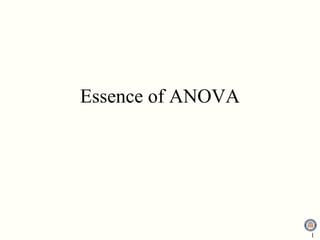7. Error
SSWithin groups
• SSw = 300
7
8. SSTotal
• SST = 360
• SST = SSB + SSW = 360
8
9. One-Way F
• SSB = 300
• dfB = 2
• MSB = 30
• dfW = 27
• MSW = 11.11
• F = 2.70
• Decision rule: Reject H0 if F > 3.36
• Decision: Fail to reject H0; 2.70 < 3.36
9
11. Statistical Conclusion
• F(dfb, dferror) = obtained value, p value.
• Conclusion about theoretical hypothesis, F(2, 27) = 2.70,
p > .05.
• Means, SDs, and effect size extra on exam.
11
17. Repeated Measures F
• MSB = 30 (same as one-way)
• SSerror = 150; SSsubjects = 150
• dferror = 18
• MSerror = 8.33
• FB = 3.60
• Decision rule: Reject H0 if F > 3.56
Decision: Reject H0; 3.60 > 3.56; α = .
05
• Note: A larger F than with a one-way
(F = 2.70)
• Mssubjects = 16.67
• Fsubjects = 2.00
• Fsubjects is used in ω2 (measure of effect
size)
17
18. Summary Table
Source SS df MS F
Between treatments 60 2 30.00 3.60 *
Within treatments 300 27
Between subjects 150 9 16.67 2.00
Error 150 18 8.33
Total 360 29
*p < .05
18
19. Two-Way ANOVA Example
Factor A
Lev 1 Lev 2 Lev3
3 2 9
1 5 9
Lev 1 1 9 13 90
6 7 6
Factor B 4 7 8
0 3 0
Lev 2 2 8 0
0 3 0 30
0 3 5
3 3 0
20 50 50
Same data
19
20. SSA = Between A treatments
SSB = Between B treatments
Factor A
Lev 1 Lev 2 Lev3
• SSA = between treatment for factor A 3 2 9
1 5 9
Lev 1 1 9 13 90
• SSB = between treatment for factor B 6 7 6
Factor B 4 7 8
• SSA = 60 (same as one-way SSB 0 3 0
Lev 2 2 8 0
& repeated measures) 0 3 0 30
0 3 5
• SSB = [902/15 + 302/15] – 1202/30 = 120 3 3 0
20 50 50
Factor B
Lev 1 Lev2
3 0
1 2
Lev 1 1 0 20
6 0
4 3
Factor A 2 3
5 8
Lev 2 9 3 50
7 3
7 3
9 0
9 0
Lev 3 13 0 50
6 5
8 0
90 30 20
21. Interaction
• SSAxB = 60
Factor A
Lev 1 Lev 2 Lev3
3 2 9
1 5 9
Lev 1 1 9 13 90
6 7 6
Factor B 4 7 8
0 3 0
Lev 2 2 8 0
0 3 0 30
0 3 5
3 3 0
20 50 50
21
22. Error
SSWithin groups
• SSW = 120
Factor A
Lev 1 Lev 2 Lev3
3 2 9
1 5 9
Lev 1 1 9 13 90
6 7 6
Factor B 4 7 8
0 3 0
Lev 2 2 8 0
0 3 0 30
0 3 5
3 3 0
20 50 50
22
23. Two-Way Fs
• SSW = 120; SSA = 60; SSB = 120; SSAxB = 60
• dfW = = 24
• MSW = 5.00
• MSA = 6.00
• Reject H0; 6.00 > 3.40
• MSB = 120; F = 24.00
• Reject H0; 24.00 > 4.26
• MSAxB = 30.00; F = 6.00
• Reject H0; 6.00 > 3.40
23
26. SSTotal
One-Way
Repeated Measures
2-Way
26
28. Error
One-Way
SSerror = – SSsubjects
Repeated Measures
Two-Way
28
30. dfT
Total number of subjects minus 1
dfT = N – 1 One-Way
dfT = N – 1 Repeated Measures
dfT = N – 1 Two-Way
30
31. dfB
Each level minus 1
dfB = k – 1 One-Way
dfB = k – 1 Repeated Measures
dfsubjects = n – 1 Repeated Measures
dfA = j – 1 Two-Way
dfB = k – 1 31
32. dfw
Number of subjects in each treatment minus 1
dfw = N – k One-Way
dfW = N – k Repeated Measures
dfw = N – jk Two-Way
32
34. F Ratios
• Divide MSbetween by the error term
• For one-way and two-way the error term is
MSwithin
• For repeated measures, the Mserror =
(SSwithin − SSbetween subjects)/dferror
34
35. Null Hypothesis
• H0: µ1 = µ2 = µ3; one-way
• H0: µ1 = µ2 = µ3; repeated measures
• H0: µA1 = µA2; two-way (2x2)
• H0: µA x µB = 0; two-way (2x2)
35
36. Alternative Hypothesis
• H1: Not H0; one-way
• H1: Not H0; repeated measures
• H1: µA1 ≠ µA2 two-way (2x2)
• H1: µA x µB ≠ 0; two-way (2x2)
36
41. The Essential Formulas
Use for one-way, repeated measures (between treatments and between subjects),
both factors of two-way
Use for all ANOVAs
The total SS for all ANOVAS.
41
